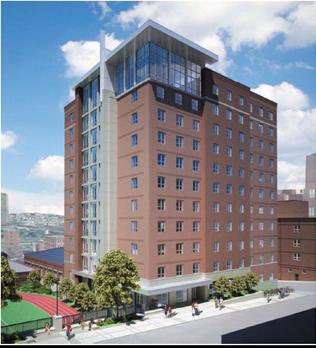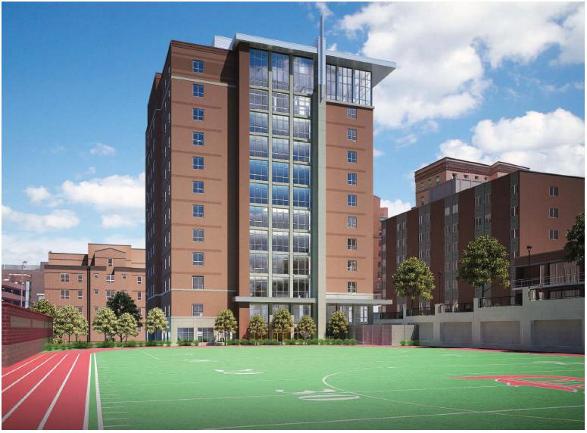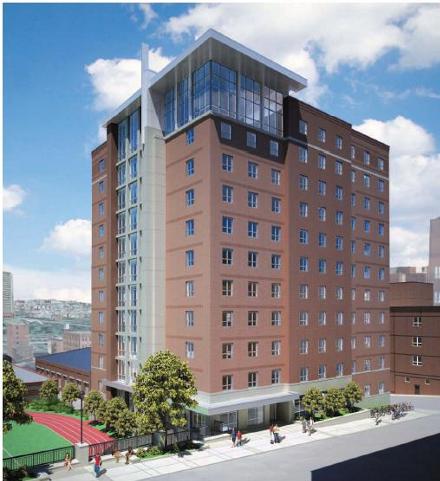



|
BUILDING STATISTICS
General Building Data
Building Name: Duquesne University Des Places Residence Hall Location/Site: Duquesne University, Pittsburgh, Pennsylvania Building Occupant: Duquesne University Occupancy Type: Residence Hall / Student Dormitory Size: 131,438 ft² Overall Project Cost: Estimated to be $27,535,000 Project Delivery Method: Design-Bid-Build Dates of Construction: Start Date: March 1, 2010 End Date: August 7, 2012 Stories Above Grade/Total Levels: 11 stories above grade 13 total levels Primary Project Team: -Owner: Duquesne University (www.duq.edu) -Construction Management Agency: Regency Construction Services Inc. (www.regencycsi.com) -Architect: WTW Architects (www.wtwarchitects.com) -Landscape Architect: LaQuatra Bonci (www.laquatrabonci.com) -Mechanical Engineer: CJL Engineering (www.cjlengineering.com) -Electrical Engineer: CJL Engineering -Structural Engineer: Barber and Hoffman Inc. (www.barberhoffman.com) -Civil Engineer: Gateway Engineers Inc. (www.gatewayengineers.com)
Architecture
The exterior design of Des Places Residence Hall is largely influenced by the buildings that surround it and by entire campus of Duquesne. Most of Duquesne University’s buildings use brick and glass for their exterior facades and this is especially true for the buildings adjacent to the site of Des Places. The architects designing this building wanted it to stand out, but at the same time it needed to mesh well with its surroundings. The building blends in nicely with the rest of Duquesne’s campus through the use of glass and brick for the exterior façade, but its modern design and the large continuous glass façade on its west elevation allow the residence hall to be an eye-catching structure as well. The glass wall that runs up the entire west side of the building also ties the interior design of the building into its exterior design. The common areas on floors three through eleven (which compose of the laundry room and lounge) are all in the same area of each floor, which allow the glass wall on these floors to appear as one continuous and uniform vertical strip from the outside of the building. This glass strip then continues to the highest floor of the structure where it extends horizontally to surround the large conference room on Floor 12. The interior of the building is mostly private spaces, with the vast majority of public space on the ground level and highest level (Floor 12). The basement houses most of the storage and mechanical space for the building, and is intended only for the use of the maintenance crew that will keep the building operational. The ground floor consists mostly of residential units, but there are also entrance lobbies for the building and offices for employees of Duquesne University. Floors 3 through 11 are almost identical and are composed entirely of residential units and a common student lounge and laundry area that serve as a public gathering place for students living on each floor. Floor 12 is still dominated by private residential rooms, with the exception of one large conference space in the southwest corner of the building. There is a central service shaft in the middle of the building that runs through every floor. This shaft takes care of the buildings circulation by housing the stairwells and elevators for the structure and it provides storage and electrical rooms for all of the dormitory floors. Every residential unit in the building is connected to a central hallway on each floor through one door. They consist of one to three bedrooms (depending on the intended use) and private bathrooms. Each unit will also be equipped with appropriate furniture to accommodate all residents, such as desks, chairs and beds. There are handicap accessible residential units on each floor of the residence hall as well. No zoning or historical requirements affected the design of this building, but all of the most recent national codes were followed. These codes are listed below: -International Building Code 2009 (IBC) -International Energy Code 2009 (IEC) -International Fire Code 2009 (IFC) -International Mechanical Code 2009 (IMC) -International Plumbing Code 2009 (IPC) -National Electric Code 2008 (NEC) -Pennsylvania Department of Labor and Industry-Universal Accessibility Code (L&I)
Building Enclosure
Roof and Slab on Grade
The roof will be an 8” precast hollow-core concrete plank that is supported by the webs of steel beams. A two inch concrete topping will be added on top of the precast plank, followed by approximately 6 inches of spray polyurethane foam insulation and a white top coating. This entire roof assembly is estimated to have a total R-Value of 44.87 ft²*°F*h/BTU. The slab on grade at the basement level of the building will be a reinforced concrete slab placed on top of a 10-mil polyethylene vapor barrier and compacted stone fill.
Exterior Facades
The exterior façade of Des Places is primarily a masonry wall, with some large storefront windows on the ground level and a glass façade running up the middle of the west wall in line with the student lounges and laundry rooms on floors three through twelve. Two exterior renderings shown below illustrate the different facades of the building in the context of its site on Duquesne’s campus.
WTW Rendering #1
WTW Rendering #2
The masonry wall consists of 3-5/8 inch face brick followed by a 1-7/8 inch air cavity, a 3 inch spray layer of urethane insulation, a ½ inch of densglass sheathing, an air space for metal studs and finally a layer of 5/8 inch gypsum board on the interior. The overall R-Value for the wall is 25.54 ft²*°F*h/BTU, which is relatively high. All of the glass for this building will be made by Pittsburgh Paint and Glass. The windows in the masonry wall will consist of two panes of glass. The west elevation will use Solarban 70XL Solargray glass followed by a clear pane, which has an overall U-Value of 0.28 BTU/ft²*°F*h in the winter. The windows on the other three elevations will use a Solarban 60 Solargray pane followed by clear glass, which has a U-Value of 0.29 BTU/ft²*°F*h in the winter. The curtain wall on the west elevation uses an aluminum framing system with low-e, high performance non-reflective glass that has an overall U-Value of 0.29 BTU/ft²*°F*h.
Sustainability Features
The Des Places project has had an emphasis on sustainability throughout the design process and will continue this focus throughout all phases of construction. Duquesne University is requiring that the building achieve a LEED certification at the very minimum. During the design process, energy modeling and payback analysis has been performed for the building by CJL Engineering, using the program TRACE. For the plumbing, the building will save on water consumption by using low flow fixtures for the faucets, shower heads, sinks and toilets. Water use will also be minimized through the landscaping design by using plants that do not require any irrigation. The HVAC and electrical systems have also been designed with sustainability in mind. There will be occupancy sensors installed throughout the building, so that lights will only be on in spaces where people are present and natural day lighting has been used to save on the amount of artificial lighting needed during the day. High efficiency fixtures will be used throughout the building as well. All of the exterior lighting will be done by LED fixtures and all of the dorm rooms will be lit by T5 high output fluorescent fixtures. The mechanical system will lower the building’s energy consumption by using a desiccant wheel in the air handling unit. This wheel will rotate between the return air being exhausted to the outside and the outdoor air being introduced into the building and transfer some of the sensible and latent heat from the exhaust air to the incoming supply air. There will also be a small wind turbine placed in the outdoor air plenum for the air handling unit in the penthouse. The wind turbine will produce electricity while the AHU is pulling outdoor air through the plenum. Duquesne will maintain their emphasis on LEED accreditation during the construction process by only hiring contractors and subcontractors who are committed to sustainable practices, such as the segregation and recycling of construction waste and protecting indoor environmental quality. One unique strategy that is being considered by the construction team to promote sustainability involves recycling the rubble created by the demolition of the existing dormitory on the future site of Des Places. When the building is destroyed the contractor can crush old building materials such as the brick and concrete masonry units into fine enough pieces to be used as infill underneath the slab on grade. This will drastically reduce the amount of stone infill that they will need to bring onto the site. The university will also make a strong effort to use local materials with a high recycled content as well as certified wood and low emitting building products.
Structural
The superstructure of Des Places consists of steel framing made with ASTM A50 carbon steel. The columns and beams are configured in an orthogonal and regular pattern on every floor above grade. There is also a 12 inch reinforced concrete shear wall around the central core of the building for additional lateral resistance. The floors above grade will be 8” precast hollow-core concrete planks nested within the webs of the wide flange beams. There will also be a 3” topping slab of concrete on each floor to provide a finished level surface and fill in any gaps between the concrete planks and structural steel. The structure of the roof will consist of an 8” precast hollow-core concrete plank with a white TPO roof system on top. The roof is also supported by the webs of steel beams. The exterior walls primarily consist of a masonry curtain wall system with openings for windows. There is also a glass curtain wall on the west elevation of Des Places. The foundation is supported by grade beams that transfer the loads from the reinforced concrete walls to drilled concrete piers spaced roughly 8 feet apart. The piers range in size from 30 in. to 60 in. in diameter, with the thicker shafts lying underneath the perimeter of the interior concrete shear wall. The foundation piers are drilled 8 feet to 10 feet into the bedrock below, depending on their location.
Construction
Des Places Residence Hall is a Design-Bid-Build project with an estimated cost of $27,535,000. Utility feeds are currently being relocated to appropriate locations on the building site and the demolition of the existing building is scheduled to begin in February of 2011. The actual construction of Des Places will begin in March of 2011 with a scheduled completion date of August 1, 2012. The general contractor has not yet been decided, because the final construction documents were just recently completed in early September. Regency Construction Services Inc. was hired as a construction management agency to perform pre-construction tasks during the design process. Duquesne University has required that this building receive at least a LEED certification, and the owners focus on sustainability will continue throughout the construction process. Duquesne will only hire contractors and subcontractors that have proven that they are committed to sustainable practices. One of the more unique sustainable ideas being considered for this project is the recycling of rubble created by the demolition of the existing building. The plan is to crush the old building materials like brick and concrete into fine enough pieces to be used as infill beneath the slab on grade, instead of bringing in new infill to the site. Duquesne University is also putting a strong emphasis on using local materials with high recycled content and low emitting products for the construction of Des Places.
Electrical
The main electrical feed will be provided through an existing Duquesne Light manhole on the site, using a 23 KV cable. This cable will connect to a 23 KV Duquesne Light pad mount transformer, that will bring the power supply down to a 277/480 V, three phase, four wire cable. The transformer then feeds one 2000 A, 277/480 V switchboard in the basement that distributes power to panelboards located throughout the building. Five main panelboards distribute the power needed for receptacles and lighting on each floor. These panel boards are all 120/208 V and range in size from 400 to 800 A. Every two person bedroom is equipped with four double-duplex receptacle outlets and every private bathroom has two double-duplex receptacles. Emergency power is supplied by a 250 KW, 277/480 V diesel powered generator. The generator is located in a separate room in the basement and is equipped with an exhaust system that brings air from the room directly outside. A link to the pdf file of the single line diagram is given below for a more detailed view of the electrical distribution system.
Single Line Diagram (Drawing E5.0)
Lighting
Des Places uses a variety of LED, T5 and TRT fixtures to save energy on lighting throughout the building. All fixture ballasts are pre-programmed and rated at 120 V. The lighting power density of Des Places is 0.74 W/ft2. This is well below the acceptable limit of 1.0 W/ft2 for dormitory buildings, as stated in section 9 of ASHRAE Standard 90.1. T5 ceiling mounted high output fixtures are used to light all of the private dormitory space in the building. T8 linear fluorescent fixtures are used for all of the mechanical space and recessed can TRT fixtures are used for the majority of the hallways and public areas. The conference room on the fourth floor uses a mixture of T8 fluorescent hanging pendants and recessed can LED lights. The lighting for every space will be controlled separately and connected to occupancy sensors, so that fixtures are only turned on when there are people in the room. A pdf file of the lighting fixture schedule is given below.
Mechanical
A large majority of the rooms in Des Places are conditioned by individual four pipe fan coil units. These fan coil units range in size from 300 cfm to 1200 cfm based on the load demands of the space. Each unit is connected to a thermostat that can run on automatic controls or be set to a desired temperature by the occupant. The only spaces that are not fully conditioned in the building are the storage and mechanical rooms. These zones are conditioned with unit heaters. A 100% outdoor air energy recovery unit in the mechanical penthouse provides outdoor air to the entire building. The energy recovery unit saves energy by using a desiccant wheel that picks up latent and sensible heat from the return air plenum and transfers it to the supply air plenum. The supply fan for ERU-1 is controlled by a variable frequency drive to save on energy consumption as well. The building receives its chilled water and steam from the central plants on Duquesne’s campus. These main lines are fed into the building from underground piping through the south wall of Floor 1. Both the chilled water and steam for the building come from an outside source, so no chillers or boilers are needed for Des Places. The steam is converted to hot water immediately after entering the building and two pumps circulate the hot water to all of the fan coil units, unit heaters, cabinet heaters and ERU-1. The chilled water is circulated through the building by two pumps as well.
Fire Protection
The entire structure is fully sprinklered in accordance with NFPA 13 and 14 standards and the requirements given by Duquesne University’s insurance underwriters. A 75 HP, 750 gpm pump will circulate the water through the fire suppression piping. Smoke detectors and signaling devices are provided in each dormitory room and the entire system is compatible with the university’s Simplex Command System.
Transportation
All of the vertical circulation for Des Places is contained in the central service shaft that runs up the entire length of the building. This central shaft has three elevators and two stairwells that are surrounded by the proper fire-rated walls. The elevators and one of the stairwells stop on the twelfth floor so the penthouse above is only accessible by one set of stairs. The circulation space for each floor consists of a central hallway that wraps around the service shaft on the interior of the building. There are two different service entrances on the first floor of Des Places and only one main entrance on the ground floor for residents and visitors. The decision to only have one main entrance for the building was made for security purposes.
Telecommunications
Des Places is wired with Category 6 cabling and patch panels that are connected to data and telephone outlets throughout the building. There is a data closet on each floor and the wiring in all of these closets are connected together at the basement level right before the service entrance. Telecommunications wiring is distributed throughout each floor with conduit or cable tray above the ceiling. Each dormitory bedroom is equipped with one data outlet and one cable television coax outlet.
Security System
Due to the urban environment surrounding the Duquesne campus, security was a large part of the design of Des Places. There is only one student entrance into the building, with a 24 hour front desk to monitor people entering and leaving. Both the student entrance and the two service entrances are equipped with card access and there are alarms on every perimeter door. The dormitory units are equipped with card or key access as well and there are individual deadbolt locks for all of the bedrooms within each unit. Camera surveillance is used to monitor the public areas of the building.
|












|
User Note: While great efforts have been taken to provide accurate and complete information on the pages of CPEP, please be aware that the information contained herewith is considered a work‐in progress for this thesis project. Modifications and changes related to the original building designs and construction methodologies for this senior thesis project are solely the interpretation of Peter Edwards. Changes and discrepancies in no way imply that the original design contained errors or was flawed. Differing assumptions, code references, requirements, and methodologies have been incorporated into this thesis project; therefore, investigation results may vary from the original design.
This Page was last updated on 4/19/2011, by Peter Edwards and is hosted by the Architectural Engineering Department © 2010 |
|
Peter Edwards |
|
PITTSBURGH, PA |
|
Architectural Engineering |
Mechanical Engineering |
The Pennsylvania State University |
|
DUQUESNE UNIVERSITY |
|
Contact: pie5002@psu.edu |

